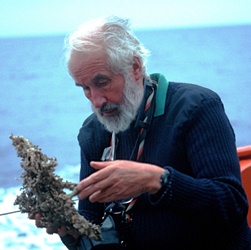 Pioneering marine geologist and biologist whose manned submersible dives illuminated the cold water corals of UK western shelf.
Pioneering marine geologist and biologist whose manned submersible dives illuminated the cold water corals of UK western shelf.
John was a marine scientist who worked on the boundary between geology and biology by studying modern shelf sea environments, how these control the distribution of organisms living there and how these organisms became preserved in the fossil record. More specifically he focused on those with calcareous skeletons such as molluscs and corals, their ecology and taphonomy, and how they contributed to the production of calcareous sediment on the UK shelf.
Picture: Photo by André Freiwald taken in 97 aboard ship, with his beloved coral.
Born and educated in Edinburgh, John obtained a first class honours degree from Edinburgh University. After a year at Caltech he continued at Edinburgh with a PhD studying how bivalve molluscs became preserved in the intertidal sediments of the Solway Firth. Using an ‘actuopalaeontological’ (Aktuopaläontologie) approach, being promoted at that time by German workers such as W Schäfer, he was able to demonstrate the differences between shell beds formed on tidal flat surfaces and those on the floors of tidal channels and how different bivalve species were preferentially preserved in these sediments.
IOS & classic papers
Following his PhD in 1965, John obtained a lectureship for four to five years at Aberdeen before beginning his productive career at the Institute of Oceanographic Sciences (IOS), near Godalming, Surrey. Here he joined an active research group who were making major advances in the hydrography, sedimentology, and ecology of the UK’s shelf seas using innovative equipment such as side-scan sonar. At IOS John was one of the first to use manned submersibles to study deep-water coral reefs or thickets in waters 200-300m down off the western shelf of the British Isles. This work led to a number of classic papers and his major contribution to our science. Fortunately, the videos and commentaries of some of his 1973 dives have been saved by colleagues working with the British Film Institute and can be viewed at http://www.lophelia.org/case-studies/pisces-and-rockall-bank/pisces-videos.
In these pioneering submersible dives John made critical observations on how cold-water coral patches formed by Lophelia pertusa developed to form coral rings; large colonies expanding out from existing small fragments of hard substrate. Today, referred to as ‘Wilson rings’, the environmental controls on these formations are still of research interest. Working in the cramped conditions in Pisces submersibles John’s keen eye and observational skills were the vital ingredients that laid foundations for work on cold-water corals that has been growing exponentially since the late 1990s.
Royal Holloway
With the closure of the IOS at Godalming in 1995 John moved to an Honorary Research Fellowship at Royal Holloway University of London where he carried out research on material collected during his many IOS cruises and assisted with teaching and PhD research supervision. A fortuitous meeting with André Freiwald led to fruitful collaboration on Lophelia reefs and thickets - most notably, the extensive Sula reef on the Norwegian shelf.
Throughout his career John was always the most enthusiastic and supportive colleague and mentor. This enthusiasm for his subject was infectious and no one who worked alongside John at sea or back in the lab will forget the passion he brought to his work and his sheer joy at seeing something new or unexpected for the first time.
Outside his passion for his subject John was an avid collector of militaria, memorabilia from the White Star Line and the Titanic (his father was a nautical engineer who transferred skills to build an oil refinery for the Burma Oil Company). John is survived by his wife Leta, his two sons, Angus and Bruce, and by three grandchildren Jonathon, Hannah and Chloe.
By Dan Bosence and Murray Roberts with assistance from Leta Wilson. Photo by André Freiwald.